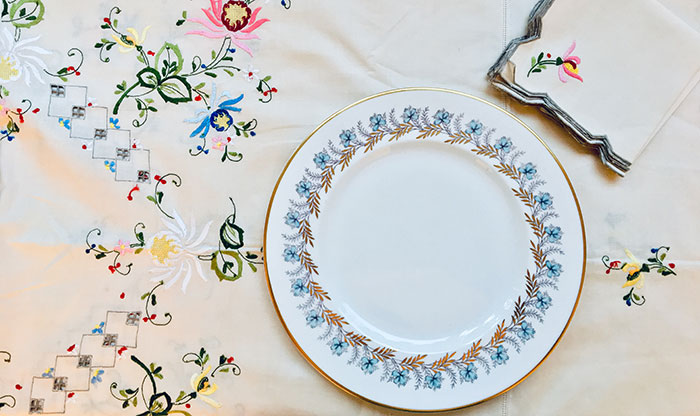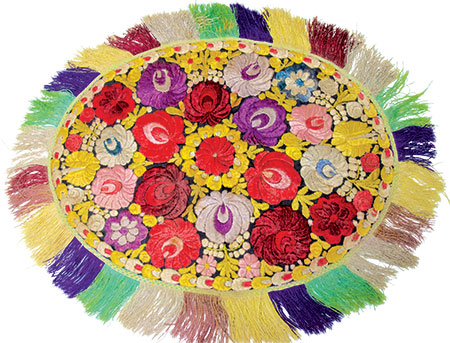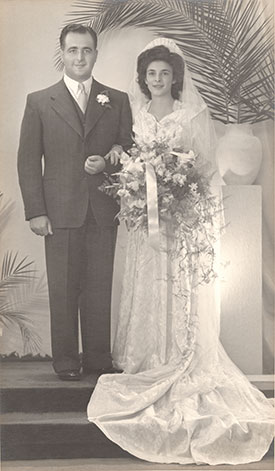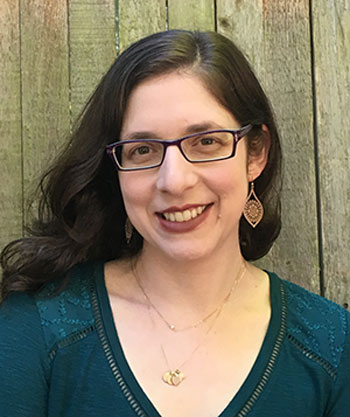Family
Feature
Inheriting Family Heirlooms, and the Stories of Migration They Tell
When I go home to Richmond, Va., the sounds and feelings of being there are the same as ever. The humidity and humming crickets drift together in a lazy summer haze; ivy and moss pile beneath the dogwood trees. Now, though, I bring my children home with me, which forces a reckoning with the stuff of my childhood. I mean that mostly literally: A lot of my physical belongings are still there. My parents would love nothing more than for me to take it all, dispatch it to charity or designate it for recycling and the dump, but I have successfully negotiated a gradual withdrawal from this familial territory.

At the start of each summer visit, as soon as we arrive, the boys—7 and 9—ransack my childhood bedroom. Barely having walked through the door, they are kicking off their sneakers and dropping their rolling suitcases in the hallway. They then grab a stepstool or chair, reach up and plunder the upper shelves of my closet. A world of wonders awaits them: a leather satchel of postcards, a pink plastic bin with all manner of girlish miscellany, puzzles, figurines, photo albums, jewelry. Little bounty hunters, my sons excitedly dig and discuss their options, for each is allowed to choose one memento to bring back to Seattle each year. Which treasure from Ima’s past will it be: polished gemstones or shark teeth from the science museum? Coin replicas from Colonial Williamsburg and Monticello? Seashells from our many trips to the Outer Banks?
One year, my younger son discovered my medals for high school track championships. “You used to run fast?” he asked incredulously, more used to seeing me sunk deep in the sofa with my feet up, nursing a cup of tea at day’s end. I told him about the 4×400 meter relay and how it was always the last race at our track meets, how my teammates and I had to stay warmed up and then run in the near-dark as evening turned to night. I’d tap my feet as I waited anxiously for the baton, run the seemingly interminable lap as fast as I could, then pass the baton to the next runner. “Stick!” we’d shout at the transition point, then double over and gasp for air. My son listened, nodded and squinted, considering the medal’s worth against its competitors, a strawberry-shaped eraser and a googly eyed finger puppet. For a fleeting moment, he had glimpsed my history before motherhood.
Over the last few years, I have also started asking more questions about objects around my childhood home—items that had belonged to my relatives back in Zimbabwe, my parents’ birthplace, or in South Africa, where some of my grandparents and great-grandparents had lived. I am trying to gather the stories that accompany these objects, placing them in space and time with as much detail as possible. My goal is to write a memoir that traces my family’s 20th-century journeys from the Levant and Lithuania into Africa and beyond.

During a recent visit, my mom and I were poking around the dining room sideboard when I noticed a beautiful oval cloth, densely embroidered with flowers and surrounded by fringed threads. It had belonged to my great-grandmother, Estrella Galante, who had emigrated from the Mediterranean island of Rhodes in the early 1920s. She was at the vanguard of waves of immigration that crested in the late 1920s and ’30s and brought an estimated 2,000 Jews from Rhodes to central and southern Africa. This influx created significant pockets of Sephardic Jews within colonial metropoles like Elizabethville (now Lubumbashi, Congo) and Salisbury (now Harare, Zimbabwe). According to my mom, a turquoise blue bowl had sat on the cloth in the lounge of Granny Estrella’s house in Harare. My mother and her sisters would bike over to the house every day after school to spend time with Estrella and her husband, Haim, an Ottoman Jew who had emigrated even earlier and who had eventually built an import-export business called the Anglo-African Shipping Company.
Some heirlooms spark an immediate memory while other items pose more of a mystery to be solved. My mom recently found a pile of tablecloths and tiny starched napkins that look vaguely European and hand-sewn, but she had no idea who made them. I got excited, theorizing that these were sewn by relatives and given to someone upon her wedding.
The émigré community in Zimbabwe was incredibly close—cousins growing up in such proximity that they were like siblings, and grandparents living just around the corner. The women used to get together to bake for special occasions, chatting in Ladino as they shaped bulemas (savory pastries) and biscocho cookies. Perhaps they had also gathered to sew these linens for my grandmother Hilda—a twin daughter of Estrella—a quick-witted woman with a bright smile and cascading, dark curly hair. The linens would have been part of Hilda’s ashugar (Ladino for trousseau), maybe even placed in a baul (trunk). Her wedding to Nathan “Bing” Moss in 1948 was notable for being a union of Sephardi and Ashkenazi families, something considered unusual in its day.

I contacted my great-aunt Vivienne in Cape Town, an eyewitness to this era and an amazing source of knowledge. Over Facetime, I showed her samples of the work. She replied that these were indeed classic items in the trousseau of Sephardic girls in Africa from the 1940s through the ’60s, so it is very likely that they were gifts to Hilda that had made their way to my mother’s house. However, she said, the tablecloths were not sewn by relatives, but rather purchased. Sure enough, when I looked closely at one of them, I found a tiny price tag and a label stating “Made in China.”
Trousseaus were on my mind for another reason during my last trip to Richmond: It was the first time I visited home with my daughter, who is 1 year old. Now, casting my eye on my childhood possessions, I thought about what might delight her as she grows up. My mom, always thinking ahead, suggested that I take my mantilla-style wedding veil. I agreed, but then found myself lingering over the cramped bookshelves facing my bed, largely undisturbed since I left home for college. My eyes caught the spines of the Betsy-Tacy books, which detail the adventures of Midwestern gal pals in the early 1900s. Next to them sits Sydney Taylor’s All of a Kind Family, the beloved series about a Jewish family on New York’s Lower East Side. On the shelf above presides my very favorite, Anne of Green Gables, and the many sequels by L.M. Montgomery. I made a mental note to get these books—essential maternal heritage!—shipped to Seattle in a few years’ time.
After the boys’ most recent treasure hunt, I sat in my old room with my daughter, who was not yet crawling and happily lay on a blanket by my side. I placed all the unchosen objects back in their rightful boxes. It was then, in a lower layer of the pink plastic bin, that I found a greeting card shaped like a little girl’s dress. Reading the inside, I realized it was a card from Granny Hilda, congratulating my mother on my birth. This card was sent from Harare to Cleveland, where my parents first lived after leaving Zimbabwe in the mid-1970s. Somehow this card made its way to Virginia when my parents moved, and it ended up in one of my keepsake boxes, waiting for me to rediscover it once I had a daughter
of my own.
Holding the card now, I think about the vast distance between my mother and her parents when I was a baby, and the distance, not as vast but still significant, between myself and my parents. I think about the experiences of so many children who have struck out on their own, crossing borders and creating new identities far from home. I think about the material things—letters, pictures, tablecloths—that connect children to the houses they left behind. Pieces of paper, bolts of fabric, woven together in a chain and stretching across diasporas.
Maybe I left so many things in my childhood home because I wanted a place to return to and because I wanted my children to have a textured family past they could see and touch. Despite our era’s embrace of Marie Kondo and the new religion of decluttering, an argument can still be made for the power of physical items to convey a sense of places and people left behind.

I have come to realize that my boys are doing the same thing to my childhood room that I do to my parents’ house. Like me, they are trying to find special treasures that make their eyes light up. Like me, they see things that trigger questions about the past, that make them ask for a story. They import these tiny pieces of my Virginia childhood into their bedroom in Seattle, which is painted Superman blue and decorated with banners for the University of Washington Huskies and the Seattle Sounders soccer team. The items get squirreled away into their treasure boxes, tucked under beds or inside bookcases, perhaps bestowing a bit of totemic power, or perhaps not. In the same way, I bring something back each time I visit home: a blue-and-green Art Deco cup from Estrella’s coffee set, photographs of shtetl relatives, silver serving spoons that belonged to Hilda, who visited us in America only a handful of times but whose paper-soft arms I still remember touching as we sat at the kitchen table playing gin rummy.
When we leave home, we leave things behind. After that, we are in the import-export business of our own memories. Today, I have to choose which objects to import from my childhood into my adult life, what is worth preserving. At the same time, I have to decide which family stories I will tell my children, which truths are most important to share. The material and the spiritual, the physical and the textual, together combining through some kind of alchemy to create the singular sense of home that will limn their future memories. Achingly, I sense the distance, doubled and tripled, between my house and the far-away homes where my parents and grandparents grew up. I try to shore up my archive, ask questions and record answers, all the while preserving the precious objects I have inherited in the hopes of passing the baton to my children, who are now running the relay race with me.
It is up to them to see themselves in these narratives, to find magic in mundane items, to hear in the fluttering fringe of a flowered cloth the whisper of family ghosts.
Hannah S. Pressman writes about Jewish languages, gender and religion. She lives in Seattle with her husband and three children.








 Facebook
Facebook Instagram
Instagram Twitter
Twitter
Reuben Israel says
My late mother was Esther Galante, born 1913 in Bodrum, Turkey, and brought up as a young girl in Rhodes. She had an elder sister Violetta. They emigrated to Salisbury in the late 1930’s. My mom married my dad Marco Israel in July1939. Thank you for your beautiful memories.
Emily Schreiber says
I so enjoyed this memoir! Whenever my sons – now in their 40s – come to visit, they collect photos and other mementos to take to their homes. They have said that after I pass, most of the “stuff” I’ve accumulated over the past 50 years in this house will end up — I hate to say it — in a dumpster. Sooo, I have to deal with it all before that time. During this pandemic is the perfect time to start!!
Avrille Copans says
I loved this article. I live in San Diego(originally from South Africa) and forwarded this to my sister in SA. She had a very close friend Nicole Galante who was born in the Belgium Congo and the family later moved to South Africa.Unfortunately she could not remember her friend’s parents name. Any relation?
The wedding picture looks exactly like my parents (coincidently my Mom’s name was also Hilda).
Michele says
Like you, I moved far from my parents home that I grew up in New York. I now live in South Africa. And, like you, I didn’t clear out most of my sentimental stuff before I left. Unfortunately,after my mother passed, my father threw everything away. She was sick and it was a very stressful time.I have regrets of not taking many things from the house to either keep for myself or pass on to my children. My advice is to not to wait until that time. Take your most precious things now so when the stressful time of a parents passing comes, you won’t have to deal with the physical ‘stuff’ you left behind.
laura turbow says
this is a fantastic article!
the work of my small business, Still Life Stories (www.slstories.net) is an exactly response to finding all of those treasures in your family home – there are so many stories to tell! well done, ms pressman!
Aubrey A. Lurie says
Lovely article. Nostalgic and expressive. Regrettably, one cannot take possession of everything, and eventually much will be discarded. Keep on teaching what you can to your kids. Reminds me of how I used to sit with my Bobba while she crouched table-cloths and spoke to me in broken English of her life in Pumpian, Lithuania.